

613. $150
Chauncey Jerome fusee steeple, 1845-1855. Jerome operated out of New Haven (as stamped
on this signed movement) during the indicated period. The dark green label is difficult to read but “Chauncey Jerome | New Haven”
can be seen at the bottom. Both glasses are old, and probably original; the numbering on the painted metal dial has been strengthened,
the hands look original. The veneer on this 19.5-inch case is very nice, with no obvious repairs or chips, and both cone finials
look good. There is a large vertical split in the backboard. We could not keep this one running for more than a few minutes
but oiling the back pivots would probably help. It looks like this is an 8-day clock. Jerome fusee steeples bring about
$400 on eBay. $200-$400.
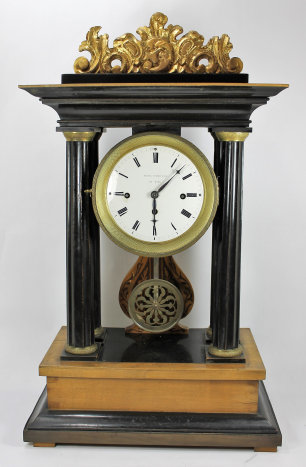
614. $275
Austrian portico repeater, ca. 1880. This wood portico clock stands 22 inches high and 13 inches
wide with a mixture of light wood and either black trim or ebony wood in places. The top shows wear from repeated cleaning,
but from the front the wear isn’t evident. There are four fluted columns with brass trim pieces, a wood top piece in gold leaf,
and a lyre backpiece behind a fancy pendulum. The dial is porcelain with a repair next to the left winding arbor, behind an
old flat glass in a brass bezel. The clock is a repeater, first sounding the quarter-hour (one, two, three, or four strikes
on a wire gong) followed by the hour count on a different wire gong. It is running robustly and striking correctly, but the
hour strike spring is not winding fully and will need to be looked at. The dial says “Franz Schaffler in Wien”. $300-$400.

615. $250
F. Kroeber “Bunkerhill”, ca. 1880. The 21.5-inch case is ebony with gold incising; the
colored leaves and berries are artistic license by a previous owner. I suppose you could paint over them in black lacquer if
you don’t find the artwork attractive. The case is in excellent condition otherwise, and this is a difficult clock to find. The old glass retains all of the gold stencil, the dial is porcelain, and there are fancy hands that look like Kroeber hands. The 8-day signed movement is running and striking the hours on a nickel bell; there is a fancy Kroeber adjustable Jacot’s regulator
pendulum (note that the pointer hand is missing the pointer portion). There is a black beat scale on the backwall and two very
nice labels on the back. A Bunkerhill sold on eBay last year for $536 and it lacked the decorated glass. There are no
sales in the Antique Clocks Price Guide. $275-$500.
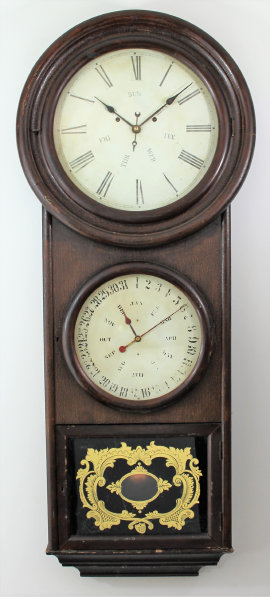
616. $1000
L.F Carter & W.W. Carter “Round Drop Wall Clock”, 1863-1868. This clock uses B.B. Lewis’
Y calendar mechanism with an 8-day, time-only, two-weight-driven unsigned Welch upside-down movement in a 48-inch rosewood case. The finish is badly alligatored and both dials are zinc replacements, painted and aged to look much older than they are. The
time dial has a 12.5-inch chapter ring. All three glasses are old, possibly original. The calendar hands are replacements,
and the minute hand has been extended. The calendar movement cover that would have held a Lewis Perpetual Calendar label is
missing; the calendar mechanism is functioning. The clock is running and keeping time, but the lower calendar is not advancing
and the connection to the upper movement will need adjustment. The pendulum stick is original, with a replaced suspension spring
and a brass bob that has lost its brass finish. There is a good label inside, a key that works on the doors, a winding crank,
and two round weights that are proper and probably original. While the finish reflects its many years of service, the case would
benefit greatly from refinishing. The gilt-decorated lower glass is quite nice. We sold one a year ago for $1825. $1000-$1500.

617. $175
Atkins Clock Co. “London”, 1859-1879. Always a favorite model, with classic styling. The rosewood veneer on this example is as close to perfect as you can get; there are a few nicks on the edges, but that’s about it. The half-columns are black with the original gold leaf trim in good shape; both glasses are old, with the original gilt decorations
and black backing. The dial has been repainted and possibly aged, with yellowing. The hands are old; there is an alarm
hooked up, but untested. The 8-day movement is running and striking on an unusual cathedral gong not typical of Atkins clocks,
but it looks original and there is no evidence of another mounting. A very good label inside. We sold one in similar condition
to this one in January last year for $283. $200-$250.
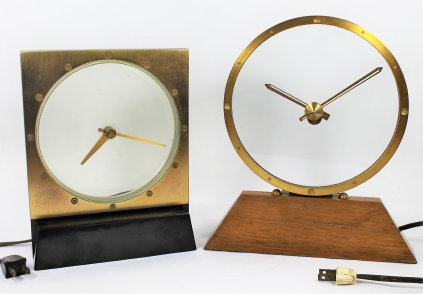
618. $100
Two Etalage mystery clocks. On the left, Etalage “MagiClock”, ca.
1955. The maker isn’t indicated, but these were sold by several firms out of New York in the 1950’s. There is an Haydon
electric motor in the base that turns two small gears that rotate the two concave plastic dials, one in front for the minute hand
and the one in back for the hour hand. The gears aren’t engaging the plastic disks on this clock so it is only right twice a
day, but the motor is running. You might be able to get the disks to engage. The plastic disks are also a bit roughed
up, and the gold finish on the case is rough. The base that holds the motor is black plastic. You can read more about
these clocks at Roger Russell’s webpage “The clocks of Leendert Prins”. $50-$100. On the right, Etalage Reclame Corp.
“Prins”, ca. 1948. Leendert Prins patented the first “mystery clock” where the single glass dial rotates with an attached hand
assembly; this patent was later bought by Jefferson Electric Co. and led to the many “Golden” mystery clocks you can now find on eBay
and, occasionally, here. This was the first model. It appears they were all made at this location in New York and
marketed under various names by different companies. It stands on an oak base that houses the electric motor made by Haydon
Mfg. Co. which drives the glass dial through one full rotation every hour. There is a gear ring on the glass hidden by the gold-plated
bezel. The clock stands 10-inches tall and is a bit top-heavy; the bezel is also a bit loose on its stand, but probably could
be tightened up if you wish to remove the motor. The clock is running and keeping time, but a bit noisy, and the glass is loose
in the bezel. The power cord is original, as are all the parts. The gold-plated bezel and hands show considerable wear,
corrosion and oxidation, and some of the finish has been polished off. I have seen only two of these clocks, they are not common. But this is the original “mystery clock”; one sold on eBay in March 2017 for $237. $100-$200.

619. $300
Bradley & Hubbard “Continental” blinking eye clock, ca. 1860. A nicely repainted
cast iron novelty, 17 inches high. The 30-hour unsigned lever movement is running. The eyes are original, also repainted,
and rock up and down nicely with the movement. The glass in the bezel is old, the paper dial replaced, and the hands don’t match. This is a very early scalloped base, signed underneath “Bradley & Hubbard, Patent applied for 1857 PCF”. $300-$500.
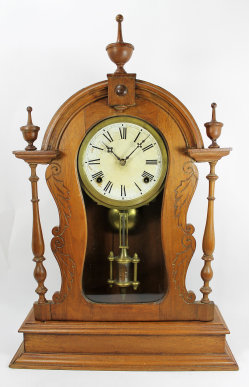
620. $100
Ansonia “Mantel Monogram”, ca. 1874. Not a common clock; there are no listings in the Antique
Clocks Price Guide. The case is walnut and in need of a waxing as the finish is dull. It stands 23 inches tall with the
center finial, all of which look correct or close matches, but the right finial needs some touch-up at the neck. The case design
differs slightly from the catalog illustration on page 446 of Ly’s book on Ansonia clocks – note the curved corners in the door glass
frame vs the acute angle corners in the illustration. It has been reglued in places and a bit sloppily. The pendulum also
differs from the illustration. The dial paper shows some wear and is not signed; the 8-day time-and-strike movement is signed
and running. The door glass is old; there is no label, but the book says it was manufactured by Ansonia Brass and Copper Co.
We sold one in July for $125. $125-$200.
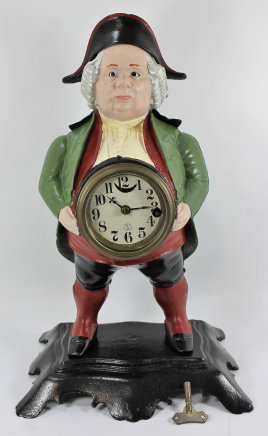
621. $75
Seth Thomas adamantine mantel, ca. 1906. We couldn’t find this one in Ly’s books on Seth
Thomas clocks, but that is not surprising as Seth Thomas made dozens of models over the years. This is a large clock, 17.5 inches
wide by 12.25 inches high, black adamantine with red marble adamantine trim on the front, sides, and top, and adamantine onyx columns. There is a repousse gilt dial that is signed on the numbers at the bottom, all behind a flat glass in the brass bezel. I suspect
that the metal trim has been repainted. The 8-day signed movement is running and striking a cathedral gong on the hour and a
cup bell on the half-hour. $100-$150.

622. $50
Terry Clock Co. “Escort Pearl”, ca. 1885. The Terry Clock Co. was founded by Silas Burnham Terry
(son of Eli Terry) in 1867 and dissolved in 1888. This model was not listed in their 1875 catalog so it was likely made after
SB Terry’s death in 1876. It’s 8 inches high with the handle up, in black enamel with gilt and pearl trim. The lower right
mother-of-pearl trim piece is missing and there is considerable wear to the paint around the signed paper dial. There are two
side glasses. It holds a one-day lever movement with an alarm that is running. Note that the minute hand is shortened;
the alarm bell is on the bottom. One setting knob is missing and the other is a replacement that does not fit well. $50-$100.
